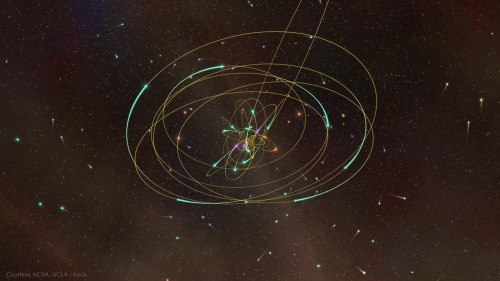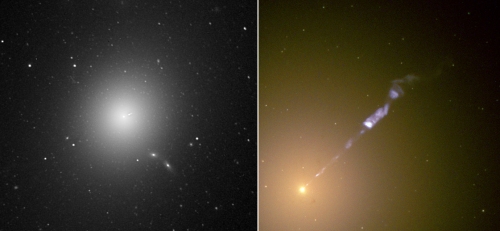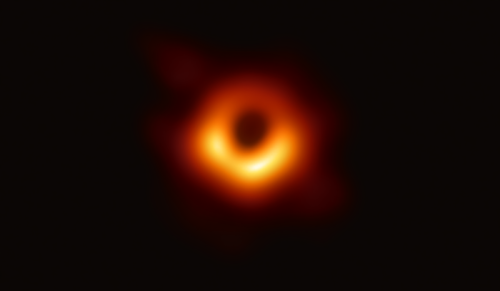by Shane L. Larson
Of all the phenomena in the Cosmos, black holes evoke a special sense of wonder in most people. What is it that captures the imagination when you hear the words “black hole?” There are countless mysterious and exotic astronomical phenomena that pique the interest of astronomers, but few of them have the evocative power over people’s imaginations that black holes do.
What are we talking about? By definition, a black hole is an object whose gravity is so strong, not even light can escape. The first person to imagine such an object was the Reverend John Michell in 1783. At the time, it was an interesting supposition since the speed of light was known to be “fast,” so such an object’s gravity had to be “strong,” but there was nothing inherently special about the speed of light itself. The same idea was later promoted quite widely by Pierre-Simon Laplace (he had a much better press machine behind him than the Reverend Michell). But the exoticness of black holes was not fully realized until the early 1900s, when two things happened.
First, in 1905, Einstein published special relativity and the scientific community rapidly tested many of the ideas and found them to be consistent with the behaviour of everything in Nature. The central tenet of special relativity, which is of paramount importance to our discussion here, is that there is an ultimate speed limit in the Cosmos, somehow built into the foundations of the structure of the Universe: you cannot travel faster than the speed of light. People often ask me, “what’s so special about the speed of light?” There is nothing special about light, there is something special about the speed. It happens that light was the first thing we ever discovered that can travel at the ultimate speed limit, so we call it “the speed of light.” The proper statement is really, “nothing can travel faster than the ultimate speed limit!”
Second, in 1915 Einstein published general relativity, which showed how to think about gravity in a way that was consistent with special relativity. Less than a month later, Karl Schwarzschild found the first astrophysical solution to the equations of general relativity, what we today call a Schwarzschild black hole. This is a perfectly spherical black hole, an object whose gravity is so strong you have to exceed the ultimate speed limit to get away from it. Extraordinarily, but perhaps not surprisingly, the size of Schwarzschild’s black hole is exactly the size predicted by Michell in 1783.
 At this point, we can begin to understand why black holes are so exotic and alluring. It’s not just that they have intense gravity. It’s that they are inescapable. If you have the sad misfortune to fall in one, you will never be able to get back out (we’ll talk about “tunnels” through black holes in a later post). That very idea of being trapped forever, incontrovertibly prevented from leaving by the laws of Nature — that’s mind boggling, and clashes with our normal sense of free-will. It very definitely has a “Nature is more dangerous than we suppose” air about it that we often only reserve for documentaries about sharks, the wild savannas of Africa, and just about all the wildlife in Australia. 🙂
At this point, we can begin to understand why black holes are so exotic and alluring. It’s not just that they have intense gravity. It’s that they are inescapable. If you have the sad misfortune to fall in one, you will never be able to get back out (we’ll talk about “tunnels” through black holes in a later post). That very idea of being trapped forever, incontrovertibly prevented from leaving by the laws of Nature — that’s mind boggling, and clashes with our normal sense of free-will. It very definitely has a “Nature is more dangerous than we suppose” air about it that we often only reserve for documentaries about sharks, the wild savannas of Africa, and just about all the wildlife in Australia. 🙂
It is the inescapable Nature of black holes that makes them interesting to think about, but it is also what makes them hard to study in astronomy. All things being equal, black holes are just about the hardest cosmic phenomena to observe because, for the most part, we study the Universe using light. By definition black holes emit no light! Recently, our burgeoning ability in gravitational wave astronomy (here are all the posts at writescience tagged “gravitational waves”) gives us a way to probe black holes directly, allowing us to understand them as single, big objects — how massive they are, how fast they might be spinning, what processes might form them. But trying to understand what is happening up close to the black hole, where the gravity is at its most intense and unusual things can happen, that’s hard. We would really like to know what happens if you are as close as possible to the black hole without being trapped, down near the surface of last escape, a place called the “event horizon.” Probing this region is the goal of one of the most ambitious projects in astronomy, called the Event Horizon Telescope.
With telescopes, we always observe light emitting objects, and watch what happens to them in the vicinity of black holes. We use these observations as a way to understand the properties of black holes and what they are capable of doing to the Universe around them. Most of the time when you hear about black hole discoveries, this is what has happened — something did something weird near a black hole, and told us the story with light! For instance, at the centers of most large galaxies astronomers find massive black holes, millions or billions of times more massive than our Sun. The one in our own galaxy is called Sgr A* (pronounced “Sagittarius A-star”). Since the 1990s, astronomers have been watching stars down in the center of the galaxy, and have now watched them long enough to see them move across the sky and make closed round paths — orbits! Something you may remember from your early exposure to astronomy is that whatever is at the middle of an orbit is the source of gravity that makes and object go around in its orbit… and at the centers of these stellar orbits we don’t see anything. The size of the stellar orbits, and the speed they move, tells us that whatever is there has four MILLION times the mass of our Sun. There is no known dark phenomena in Nature that can be that tiny, that massive, and create that much gravity other than a black hole.

Two decades of observations have shown the orbits around the 4 million solar mass black hole at the center of the Milky Way. [NCSA/UCLA/Keck]

The black hole in the center of M87 powers an enormous, energetic jet of material spewing out from the galactic core. (L) We think we were one of the first amateurs to image this jet in 2001 [Image: S. Larson/M. Murray/A. Block] . (R) HST image of the jet, for comparison. [Image: STScI/Hubble/NASA] 🙂 [Click to embigen!]
The apparent size of an object in the sky depends on how intrinsically big it is, and how far away it is. For black hole sizes, we can use the size predicted by Schwarzschild to get a sense for their diameter. If you want to tinker and get out your calculator, the diameter of a Schwarzschild black hole is given by the formula
where dbh is the diameter of the black hole, Mbh is the mass of the black hole, G is Newton’s gravitational constant, and c is the speed of light. If you put in the mass of any black hole in kilograms, then this formula tells you the diameter of the black hole in meters. A black hole the mass of the Earth has a diameter of just over 1.5 centimeters. A black hole the mass of Neptune has a diameter just a bit bigger than a human head. A black hole with the mass of the Sun has a diameter of almost 1500 meters (just under a mile). As the mass of the black hole gets larger, the diameter gets larger. So consider the two black holes we’ve discussed above: Sgr A* and M87.

A black hole with the mass of the Earth is about the size of a marble. A black hole with the mass of Neptune is about the size of your head! [Image: S. Larson]
So, what does it take to observe the Cosmos on the scales of even big black holes? Telescopes can make out things that appear very small in the sky, but how small? How big something appears depends on how far away it is. Imagine you have a friend holding a beach ball and a dime, standing at the far end of a field. In all likelihood, you can see the beach ball, but not the dime. The beach ball appears tiny, but from far away a larger object is easier to see than a smaller object. A telescope’s ability to distinguish the size of objects in this was is called its resolving power, and depends on the color of light you are using (technically, the wavelength) and the effective diameter of your telescope — the bigger the telescope, the better resolving power it has.

How large an object looks to you depends on its size and its distance. Here, you see when Michelle is very far away you can still make up the larger ball, but the smaller coin is harder to see! [Image: S. Larson]
To make the measurement, the Event Horizon Telescope team uses radio telescopes spread across the Earth, all observing simultaneously as if they were a single giant telescope the size of the planet. This kind of astronomy is called VLBI — Very Long Baseline Interferometry. The resulting picture of M87, the first released by the Event Horizon Telescope, is shown below — a brilliant ring of light, surrounding the shadow of a massive black hole, the first of its kind.

The first picture of the black hole at the heart of M87, formed by light being bent around the inner most regions of space outside the event horizon. The teams measurements show the black hole is heavier than previous measurements, totaling almost 6.5 billion times the mass of our Sun. [Image: Event Horizon Telescope Collaboration]
And this is just the beginning!
————————–
This post is the first in a series about black holes. The complete series of posts is:
Black Holes 01: Imaging the Shadow of Darkness (this post)
Black Holes 02: What are black holes made of?
Black Holes 03: Making black holes from ordinary stuff
Black Holes o4: Singularities, Tunnels, and Other Spacetime Weirdness
Black Holes 05: Inklings & Obsessions
————————–
For a great video describing the intricate details of the light interacting with the black hole to make images, check out this excellent video from the team over at Veritasium:





Pingback: Black Holes 3: Making black holes from ordinary stuff | Write Science
Pingback: Black Holes 4: Singularities, Tunnels, and Other Spacetime Weirdness | Write Science
Pingback: Black Holes 5: Inklings & Obsessions | Write Science